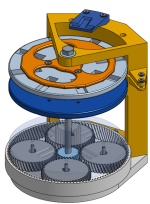Erik952
1 mW
Hey everyone! I found this forum a few days ago and went down the deep rabbit hole of reading a ton of posts about different motors, designs, epoxying and all sorts of fun stuff. I've been working on my motor for about a year now with moderate success. Between my job, my wife and my family, time is a little more scare than I'd prefer.
My background is a degree in mechanical engineering, with a minor in mechatronics. I've spent plenty of time coding Arduino and a lot more time treating engineering like an artform and just messing around. I played Kerbal space program for the longest time (logged like 3k hours) and that really got me into the enjoyment of building things that work just like you've envisioned. I've watched plenty of youtubers who work on these sort of things (I have to shout-out RCtestflight, hyperspace pirate and tom stanton) and I think I'm ready to start working on documenting my own steps of building out my project.
My long-term goal is to create my own motors for a dual motor aircraft/drone. The design of the aircraft is to follow the idea of tilt-rotors, to avoid my personal fear of landing aircraft and to solve the fact that i don't have any good makeshift runways around me. I plan on having several models as I work up to a full-scale model using a home-built turbine for power generation (this is a long shot and it is going to be a lot of fun). The goal there is to have a circuit to build both the ESC and the generator using the same controller board. The current iteration is just to get airborne with two motors and a battery, with a weight less than 5 lbs. This is the long term project and hopefully will explain some of my design choices like no back iron to drop weight.
Everything I'm making is out of 3D printed parts for prototyping. Eventually I'll move into epoxy as that seems to have a great deal of help making a sturdy stator. The tolerances aren't great, one side of my bed constantly detaches at a certain line which is annoying. I haven't tried any glues though and I'm still using the base glass plate from Creality.
My motor design is based on a 10p/9s yokeless double-rotor axial motor. The frame is held together by three 1/4" bolts with a 1/4" bolts as the shaft. I'm using 26 gauge magnet wire from McMaster, which makes winding coils a pain cause it has to have so many windings. So far, I've used a typical coil for each stator mount with about 200~ coils on each. I made a 1P serpentine winding to use and that made the motor run quite happy as well. I liked that winding much more since I could just create a giant loop and then slot it into place, but I saw Halback Hero's post where he used litz wire to create a layered serpentine coil and I'm very interested into working towards that, with the addition of metal slots for some extra torque if the weight is justified. I'm using M3 screws to bolt the typical stator coils to the frame for structural support and for a bit of iron in the electromagnet. My magnets are 30x10 mm which seem to be a lot more rectangular than most of the magnets I've seen used on here. My model includes an ability to rotate the magnets to 45 degrees. a previous model had a great success with that and i wanted to try angled vs un-angled on this motor as well. The air gaps are a bit extreme, most staying around 1mm airgap between the stator edges and then another 2mm due to the pla stator plate that it's built onto.
The Rotor (100 mm diameter)
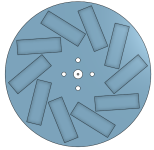
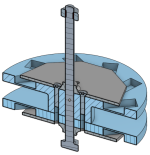
there are screws on either side of the rotor holding the grey motor coverplates to the stator, as well as ensuring the rotors don't slip. There's plenty of magnetic attraction between them to hold it steady without it.
The Stator (with 1 coil)
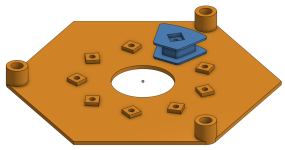
The Whole Motor
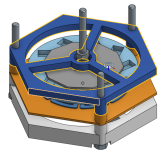
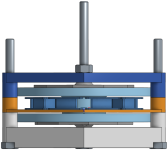

These are all from OnShape, which is a free cloud CAD software I found which is really helpful since i switch computers throughout the day.
I have a custom ESC that runs on hall effect sensors, it's currently on a breadboard as i got too eager on my perf board and packed it too tightly. I'm aiming to create a microcontroller board for each motor on the tilt rotor so they can be plug and play rotors instead of having to adjust setting in the flight controller. My power supply comes from a 0V-48V 10amp power box which is set to 12V to mimic the nimh pack I have.. A previous 3P motor had gotten to about 2-3k rpm at 12V per my Arduino code. I've been meaning to put together a test stand to measure torque using an arm and a load cell.
I'm currently printing this version, but I forgot to add the mounting for the hall effect board under the shaft on the bottom bracket, which is the piece I started printing this morning before I left for work. I'll get that redesigned and work on coding in that AS5600 into the testbed micro-controller.
My background is a degree in mechanical engineering, with a minor in mechatronics. I've spent plenty of time coding Arduino and a lot more time treating engineering like an artform and just messing around. I played Kerbal space program for the longest time (logged like 3k hours) and that really got me into the enjoyment of building things that work just like you've envisioned. I've watched plenty of youtubers who work on these sort of things (I have to shout-out RCtestflight, hyperspace pirate and tom stanton) and I think I'm ready to start working on documenting my own steps of building out my project.
My long-term goal is to create my own motors for a dual motor aircraft/drone. The design of the aircraft is to follow the idea of tilt-rotors, to avoid my personal fear of landing aircraft and to solve the fact that i don't have any good makeshift runways around me. I plan on having several models as I work up to a full-scale model using a home-built turbine for power generation (this is a long shot and it is going to be a lot of fun). The goal there is to have a circuit to build both the ESC and the generator using the same controller board. The current iteration is just to get airborne with two motors and a battery, with a weight less than 5 lbs. This is the long term project and hopefully will explain some of my design choices like no back iron to drop weight.
Everything I'm making is out of 3D printed parts for prototyping. Eventually I'll move into epoxy as that seems to have a great deal of help making a sturdy stator. The tolerances aren't great, one side of my bed constantly detaches at a certain line which is annoying. I haven't tried any glues though and I'm still using the base glass plate from Creality.
My motor design is based on a 10p/9s yokeless double-rotor axial motor. The frame is held together by three 1/4" bolts with a 1/4" bolts as the shaft. I'm using 26 gauge magnet wire from McMaster, which makes winding coils a pain cause it has to have so many windings. So far, I've used a typical coil for each stator mount with about 200~ coils on each. I made a 1P serpentine winding to use and that made the motor run quite happy as well. I liked that winding much more since I could just create a giant loop and then slot it into place, but I saw Halback Hero's post where he used litz wire to create a layered serpentine coil and I'm very interested into working towards that, with the addition of metal slots for some extra torque if the weight is justified. I'm using M3 screws to bolt the typical stator coils to the frame for structural support and for a bit of iron in the electromagnet. My magnets are 30x10 mm which seem to be a lot more rectangular than most of the magnets I've seen used on here. My model includes an ability to rotate the magnets to 45 degrees. a previous model had a great success with that and i wanted to try angled vs un-angled on this motor as well. The air gaps are a bit extreme, most staying around 1mm airgap between the stator edges and then another 2mm due to the pla stator plate that it's built onto.
The Rotor (100 mm diameter)


there are screws on either side of the rotor holding the grey motor coverplates to the stator, as well as ensuring the rotors don't slip. There's plenty of magnetic attraction between them to hold it steady without it.
The Stator (with 1 coil)

The Whole Motor



These are all from OnShape, which is a free cloud CAD software I found which is really helpful since i switch computers throughout the day.
I have a custom ESC that runs on hall effect sensors, it's currently on a breadboard as i got too eager on my perf board and packed it too tightly. I'm aiming to create a microcontroller board for each motor on the tilt rotor so they can be plug and play rotors instead of having to adjust setting in the flight controller. My power supply comes from a 0V-48V 10amp power box which is set to 12V to mimic the nimh pack I have.. A previous 3P motor had gotten to about 2-3k rpm at 12V per my Arduino code. I've been meaning to put together a test stand to measure torque using an arm and a load cell.
I'm currently printing this version, but I forgot to add the mounting for the hall effect board under the shaft on the bottom bracket, which is the piece I started printing this morning before I left for work. I'll get that redesigned and work on coding in that AS5600 into the testbed micro-controller.













